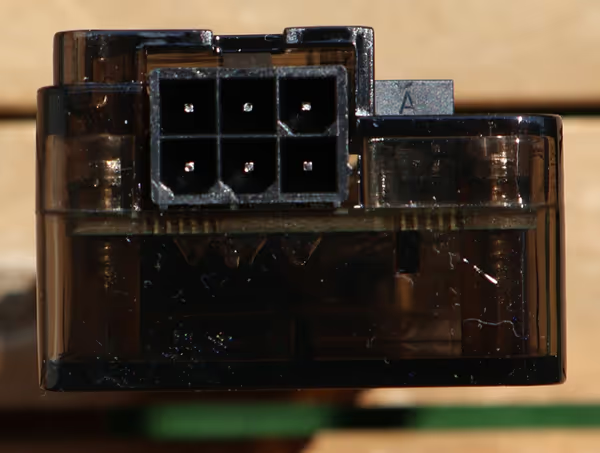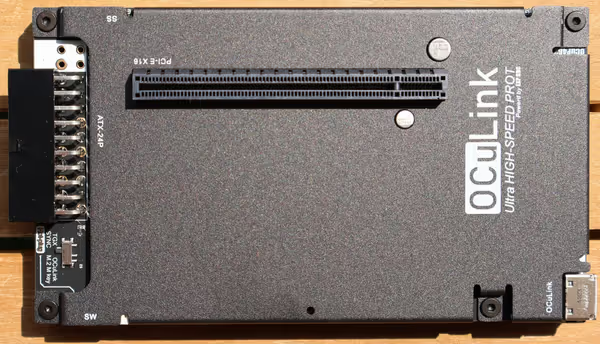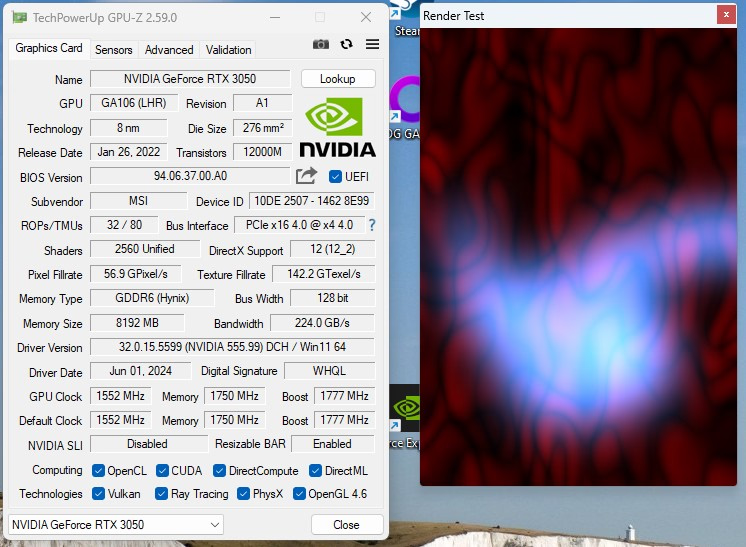A quick test of OCuP4V2 and EXP GDC OCuLink adapter boards
Recently new OCuLink adapter boards were introduced to the market, offering better PCIe 4.0 support and compatibility. You can find them on Aliexpress and other usual places for such electronics.
EXP GDC OCuLink adapter board
EXP GDC adapter board is relatively cheap and comes in a plastic housing. It can be powered by either an ATX-compatible PC power supply or a 12V DC. If you use the 12V plug to power it you can also use the PCIe power connector on the short side of the board to handle the PCIe power connector on the GPU if it has one (note that if you use 12V DC then the power adapter must have sufficient power to drive the card which may be tricky for more power hungry GPUs).



On the PCB there is also an ATX/DC power source switch - if you want to use ATX power supply you have to set it to the marked position. If you want to use 12V DC then the opposite. EXP adds an ATX adapter for power and switching the power supply on.
OCuP4V2 OCuLink adapter board
OCuP4V2 is a more advanced construction and with a higher price tag. The PCB is mounted inside a sturdy metal housing giving it more stability. It comes with ATX and SFX power supply bracket allowing to mount the power supply and the GPU on the board together. There are also enclosures for this board available.
The board requires an ATX-compatible PC power supply and can work as an OCuLink or TGX adapter board. TGX is a Lenovo adaptation of OCuLink with HotPlug support for the PCIe device (assuming the host supports it). The mode is handled by a switch on the side of the device.
When you have everything setup and connected you have to press a switch (SW
on the board) to turn it on.


Performance and compatibility tests
For testing I used GPD Win Max 2 with Ryzen 7840U, 32GB RAM, latest Windows 11 version. For connection the M.2 2230 slot was used to leverage PCIe 4.0 x4 (while the external OCuLink connector for now is limited to PCIe 3.0 due to firmware/stability issues). Alongside new boards, I've also re-tested the most popular generic
Chenyang (NFHK) adapter board I used before.
| EXP GDC | OCuP4V2 | Chenyang | |
|---|---|---|---|
| RTX 3050 | works | works | works |
| RTX 3070 | fail | fail | works |
| RX 7600 | works | works | works |
| Arc A750 | - | - | - |
Gainward RTX 3070 on EXP GDC and OCuP4V2 was recognized/labeled by Windows as Microsoft Basic Graphics Card
in GPU-Z and didn't function properly. Even with multiple reboots, it didn't change (and that's not even error 43 territory). It could be an odd case but still, OCuLink tends to have them with some cards. There are other RTX 3070 user reports using it with GPD Win Max 2 without issues.
Intel ARC graphics cards are still completely incompatible, at least with my setups - no card detection.
Bandwidth and connection tests
For the tests I used GPU-Z with its load test to check the PCIe connection version and lane count. Then I used the 3DMark API Overhead test and PCIe Express feature test benchmarks.
For Nvidia cards usually the PCIe Express test was not available with an error message You need a discrete graphics card to run this test
. 3DMark was allowed to run this test only for once for Chenyang with RTX 3070.
The API overhead benchmark is not a direct connection speed test but a relatively good indicator of it and there were no problems running it. The results are millions of draw calls per second.
| EXP GDC | OCuP4V2 | Chenyang | |
|---|---|---|---|
| RTX 3050 | PCIe 4.0 x4 20,26 mil DX12/s, 29 mil Vulkan/s |
PCIe 4.0 x4 20,36 mil DX12/s, 30,4 mil Vulkan/s |
PCIe 4.0 x4 20,27 mil DX12/s, 28,8 mil Vulkan/s |
| RTX 3070 | PCIe 4.0 x4 20,28 mil DX12/s, 27,5 mil Vulkan/s 6,69 GB/s PCIe speed test |
||
| RX 7600 | PCIe 4.0 x4 25,8 mil DX12/s, 26,5 mil Vulkan/s 7,13 GB/s PCIe speed test |
PCIe 1.1 x4 4,2 mil DX12/s, 4 mil Vulkan/s ~0,91 GB/s PCIe speed test |
PCIe 4.0 x4 30,12 mil DX12/s, 26,49 mil Vulkan/s 7,13 GB/s PCIe speed test |
Even with multiple reboots and re-connects the OCuP4V2 had problems with Radeon RX 7600 where the bandwidth was severely limited. I've seen this happen previously with Chenyang and RX 6950 XT as well. Aside from that, there were no problems with the connection.

Performance testing
For a quick performance test I used 3DMark Solar Bay and Night Raid benchmarks with a display connected to the eGPU.
| EXP GDC | OCuP4V2 | Chenyang | |
|---|---|---|---|
| RTX 3050 | 113,03 FPS Solar Raid Graphics test 78 583 Night Raid Graphics score |
115,79 FPS Solar Raid Graphics test 78 885 Night Raid Graphics score |
111,84 FPS Solar Raid Graphics test 78 685 Night Raid Graphics score |
| RTX 3070 | Solar Bay unavailable 109 715 Night Raid Graphics score |
||
| RX 7600 | 144,88 FPS Solar Raid Graphics test 116 991 Night Raid Graphics score |
147,53 FPS Solar Raid Graphics test 112 426 Night Raid Graphics score |
148,45 FPS Solar Raid Graphics test 117 297 Night Raid Graphics score |
RX 7600 reached 52 546 score in Night Raid and 39 043 in Solar Bay on Chenyang. On OCuP4V2 Night Raid score of 51 609 was slightly lower, the same as 38 801 in Solar Bay. RTX 3070 with Chenyang adapter board worked but Solar Bay benchmark was not able to run with an error message stating a GPU with Vulkan Ray Tracing API support is required.
Summary
Both adapters work as expected. OCuLink has its quirks and compatibility limitations. My Gainward RTX 3070 didn't want to work properly, while RX 7600 had connection speed problems on OCuP4V2. The problem with such results is that they are hard to reproduce - one setup will work, the other won't while having the same GPU.
If you want a more compact eGPU setup you can look at OCuP4V2 or even its enclosures. EXP GDC would be a pick if you want to use a more portable setup with a 12VDC power supply and no ATX-style power supplies. Old Chenyang also works, although some users reported PCIe 4.0 problems with it... as mentioned - there can be problems that are hard to predict.
Comment article